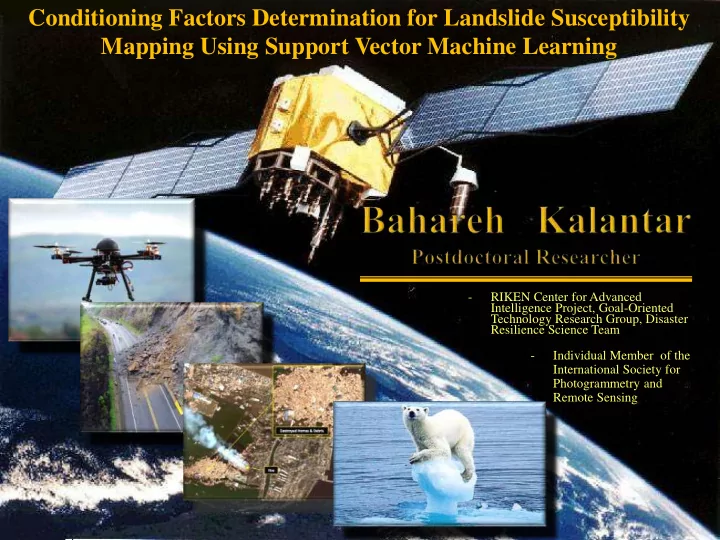

Conditioning Factors Determination for Landslide Susceptibility Mapping Using Support Vector Machine Learning - RIKEN Center for Advanced Intelligence Project, Goal-Oriented Technology Research Group, Disaster Resilience Science Team - Individual Member of the International Society for Photogrammetry and Remote Sensing
Landslides cause Landslide initiation specifically looking at the contribution of individual high fatality rates conditioning variables (or conditioning variables Landslide Susceptibility Landslide Susceptibility factors). huge property losses Risk assessments geomorphical, hydrological and Landslide analysis Landslide analysis can help topographical to detect areas prone to landslides, Identifying the appropriate conditioning factors is important specially when to provide early warning constructing a model to predict potential for affected residents. landslide area.
This research seeks to expand on previous works, and answer the following questions: (1) Despite the existing pool of landslide factors, which of these factors best predict landslides susceptibility? (2) What is the minimum number of factors to construct a model to come up with a consistent landslide potential map?
(1) Slope angle (8) Stream Power Index (SPI) (2) Slope aspect (9) Topographic Roughness Index (TRI) (3) Elevations (10) Sediment Transport Index (STI) (4) Total curvature (11) Landuse-Landcover (12) Geology (5) Profile curvature (6) Plan curvature (13) Distance from rivers (7) Topographic (14) Distance to fault Wetness Index (TWI)
To determine whether or not adding selected factors will improve the prediction of landslide susceptibility. To evaluate the performance of the SVM model based on the selected group.
Basically, the SVM tries to discover an optimal separating hyperplane that could effectively separate the input features of two classes with maximum margin. ሻ 𝑧 𝑗 (𝑥 ∗ 𝑦 𝑗 + 𝑐 − 𝜀 𝑗 ≥ 1 𝐱 is the coefficient vector that defines the hyperplane orientation in the feature space. 𝐜 is the offset of the hyperplane from the origin and 𝜺 𝒋 the positive slack variables
variance-inflated factor (VIF) 1 𝑊𝐽𝐺 = 1 − 𝑆 ′2 where 𝑆 ′ represent the multi correlation coefficient between individual feature and the other features in the model. In the current study, factors with a 𝑊𝐽𝐺 greater than 5 or 10 were identified as the high correlation and should be removed.
Pearson's correlation coefficients method 𝑌 𝑗 − ത 𝑍 𝑗 −ത 𝑌 𝑍 𝑜 𝑦𝑧 = σ 𝑗=1 𝑠 𝑜 𝑜 (𝑌 𝑗 − ത 𝑌ሻ 2 (𝑍 𝑗 −ത 𝑍ሻ 2 σ 𝑙=1 σ 𝑙=1 where 𝑌 𝑗 and 𝑍 𝑗 are the values of 𝑌 and 𝑍 for the 𝑗 th individual. A high level of colinearity is identified when the Pearson’s correlation coefficient is greater than 0.7.
Cohen’s kappa index 𝑄 𝑝𝑐𝑡 −𝑄 𝑓𝑦𝑞 𝐿 = 1−𝑄 𝑓𝑦𝑞 𝑄 𝑝𝑐𝑡 denotes the correctly classified proportion of landslide and non-landslide pixels. 𝑓𝑦𝑞 indicates the proportion of pixels expected to show 𝑄 agreement, on the basis of chance.
The area under the receiver operating characteristic curve (AUC) by evaluation the prediction and success rates was looked at to evaluate the performance of both SVMs. Values from 0.5-0.6 indicates poor, 0.6-0.7 average 0.7-0.8 as good 0.8-0.9 means very good 0.9-1 is exceptional (or excellent)
ACCURACY OF THE SVM MODEL FOR BOTH G1 AND G2 DATASETS. Training points% Testing points% G1 68% 74% G2 80% 81%
The Estimated Variance Information Factor (VIF) for Landslide Conditioning Factors. No VIF Conditioning factors 1 Aspect 1.011966 2 TWI 1.33363 3 TRI 9.315751 4 SPI 7.677249 STI 8.555234 5 6 Geology 1.070003 7 Landuse 1.024453 8 Plan Curvature 4.33E+13 9 Profile Curvature 9.01E+13 Total Curvature 1.88E+14 10 11 Slope 7.029521 12 Distance to Fault 1.013054 13 Distance to River 1.012054 14 Altitude 3.521458
Pearson Correlations Between Landslide Conditioning Factors . Conditioning Aspect TWI TRI SPI STI Geolog Landus PlanProfil Tota Slop Fault River Altitu factors y e e l e de Aspect 1.00 TWI -0.01 1.00 TRI -0.01 -0.34 1.00 SPI 0.03 0.42 -0.05 1.00 STI 0.03 0.42 0.08 0.95 1.00 Geology 0.10 0.09 -0.33 -0.06 -0.08 1.00 Landuse -0.15 0.13 -0.19 -0.03 -0.04 0.13 1.00 Plan -0.01 -0.49 0.01 -0.25 -0.36 0.04 0.03 1.00 - Profile -0.01 0.23 0.04 0.05 0.12 0.03 -0.06 0.42 1.00 Total 0.00 -0.40 -0.02 -0.16 -0.26 0.00 0.05 0.77 -0.90 1.00 - Slope -0.01 -0.36 0.81 -0.02 0.14 -0.13 -0.12 0.01 0.06 -0.051.00 - Fault -0.08 0.07 -0.16 0.02 0.00 0.21 0.01 0.02 -0.03 0.01 -0.09 1.00 River 0.04 -0.13 -0.06 -0.11 -0.11 0.06 0.15 0.14 -0.08 0.12 0.01 0.19 1.00 Altitude 0.05 -0.08 0.55 -0.06 -0.05 -0.43 -0.24 0.04 -0.01 0.03 0.03 -0.14 -0.14 1.00
Cohen's Kappa Index for the SVM Technique of Landslide Susceptibility by Removing One Conditioning Factor. G1 G2 Landslide CKI Landslide CKI conditioning factors conditioning factors Without altitude 0.34 Without altitude 0.6941 0.28 Without slope 0.5923 Without slope Without total 0.30 Without Total 0.6536 curvature curvature Without profile 0.30 Without Profile 0.6533 curvature curvature Without plan 0.32 Without plan 0.6536 curvature curvature Without aspect 0.32 Without aspect 0.6941 Without SPI 0.38 Without SPI 0.6334 Without TWI 0.28 Without TWI 0.6739 Without TRI 0.30 Without TRI 0.6122 Without STI 0.38 Without STI 0.6331 Without fault 0.6122 Without River 0.6334 Without LULC 0.6530 Without geology 0.6739
Conditioning factors such as geology, landuse, distance to river, and distance to fault to the DEM-derived dataset, provided better accuracy. SVM-G2 has higher accuracy (Testing 81% Training 80%) to compare to SVM-G1 (Testing points: 74%, Training points: 68%). High correlation between SPI and STI, total curvature and profile curvature, slope and TRI, as well as between plan curvature and total curvature. Slope is the most significant factors between both dataset (G1 and G2) followed by TWI, TRI and distance to fault for landlside susceptibility modeling.
Thank you
Recommend
More recommend